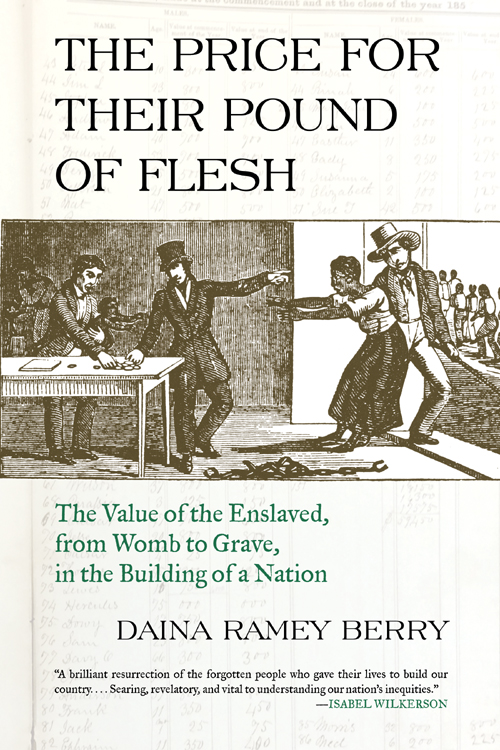
The Price for Their Pound of Flesh
The Value of the Enslaved, from Womb to Grave, in the Building of a Nation
کتاب های مرتبط
- اطلاعات
- نقد و بررسی
- دیدگاه کاربران
نقد و بررسی

Starred review from December 5, 2016
In this “financial recapitulation of black bodies and souls,” Berry, associate professor of history and African and African diaspora studies at the University of Texas at Austin, examines how slaveholders ascribed pecuniary worth to women, men, and children. Slavery took many forms across the antebellum U.S., but all enslaved people experienced their reduction to the status of chattel, bought and sold at their owner’s will. Yet surprisingly little scholarship has examined the monetary value of these individuals, whose worth increased from infancy through adolescence, peaking at the height of their productive and reproductive capacities, and declining steadily to the point where the elderly were considered nearly valueless. Upon their deaths, they might regain some financial significance, as the bodies of many were sold to medical schools for purposes of dissection. Crucially, Berry also delves into the annals of slave communities to explore the emotional strategies by which the enslaved resisted their reduction to an “exchangeable commodity,” centering their lives on spiritual beliefs that defined the soul, rather than the body, as the true location of their individuality. Berry’s groundbreaking work in the historiography of American slavery deserves a wide readership beyond academia.

November 1, 2016
What was the assigned value, the price tag, placed on the bodies of the enslaved?In this sharp, affecting study, Berry (History and African and African Diaspora Studies/Univ. of Texas; Swing the Sickle for the Harvest Is Ripe: Gender and Slavery in Antebellum Georgia, 2007, etc.) reminds us of the cold calculus at the intersection of slavery and capitalism. Assessed at each stage of their lives, in the womb and even after death, the sale price of the enslaved depended upon a number of variables: the needs, desires, and location of the buyer and the particular skills, perceived attractiveness, and sex of the bought. Beginning each of her chapters with an auction and an inventory of the economic imperatives at work, the author movingly vivifies this brutal commodification of the men, women, and children in bondage with the horrid details attending their sale: the male bodies "greased up and groomed for the auction block," the forced breeding that accounted for many family separations, the incomprehension of children sold away, the five-point scale (Berry compares it to U.S. Department of Agriculture meat grades) used to rate the health and utility of the enslaved, and the role of "breeding wenches" in populating the workforce. In addition, the author explores the flourishing cadaver trade, in which black bodies still had a post-mortem value; remarks on the emerging field of gynecology, built on research conducted on enslaved women's bodies; and touches on the matters of insurance, coroners' inquiries, and autopsies, all part of the grim calculation. Most movingly, Berry discusses what she calls "soul value," the deeply personal, spiritual value the enslaved assigned to themselves. From this place came the strength that inspired Ponto to boldly correct his auctioneer, Isaac to cheat the hangman by jumping from the gallows to meet death on his own terms, Madeline to drown herself rather than suffer repeated rape, and Celia to club her rapist to death. A well-researched, effectively presented piece of scholarship that forthrightly confronts slavery's brute essence.
COPYRIGHT(2016) Kirkus Reviews, ALL RIGHTS RESERVED.

October 15, 2016
Debut author Berry (history, African diaspora studies, Univ. of Texas, Austin) focuses primarily on the sale price and appraised value of enslaved people in the United States in the early 19th-century. Utilizing the statistics compiled by Robert William Fogel and Stanley L. Engerman for their book Time on the Cross: The Economics of American Slavery, Berry adds her own data and finds new evidence within the records of life insurance companies. In addition, she analyzes "soul value," or enslaved people's rejection of the capitalization of their bodies. The first chapters are tightly focused on the values of enslaved children, young adults, and women of reproductive age. But Berry's section on the values of adults veers off-topic with long discussions of the rebellions of Nat Turner and John Brown. The author concludes with an examination of how medical schools paid for and stole enslaved dead bodies for research, which she terms "ghost value." VERDICT Although highly readable and addressing the most heartbreaking and starkly gruesome aspects of slavery, this book doesn't add much new information to the topic. Recommended for serious scholars of slavery and African American history.--Kate Stewart, American Folklife Ctr., Washington, DC
Copyright 2016 Library Journal, LLC Used with permission.

























دیدگاه کاربران